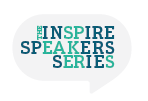By now, you know that we’ve kicked off our second season of the Inspire Speakers Series – a monthly lecture circuit we host with Phipps Conservatory and Botanical Gardens. You know that we bring national and local experts together to share their perspectives, ideas, and knowledge regarding the creation of sustainable spaces where we can all live, work, learn, and play. But did you know that something very special happens after each lecture?
On the following day, a dedicated group of teachers and school administrators gather at a local school for a private workshop with our speakers. This is part of the model for our Green Schools Academy – to expose this cohort of K-12 representatives to the experts we work so hard to convene. It gives them a unique opportunity to hear an inspiring lecture and then receive practical advice directly from our speakers the following morning.
Most recently, Natalie Jeremijenko joined our Green Schools Academy participants on a Friday morning (following a lovely sunrise group yoga session with some of the teachers) at the Environmental Charter School (ECS). I asked Shannon Merenstein, a teacher, design coach, and K-3 Thinking Lab educator at ECS, to share her experience with us…
*****
Last year at the Environmental Charter School, we piloted a K-3 program called Thinking Lab. Instead of isolating the disciplines of art, design, and environmental science, we decided to stir the pot and create an integrated curriculum for our youngest explorers. The truth is, children don’t see things in black or white/science or art, but instead are fascinated and curious about the world around them, through the lens of wonder. This kind of wonder and excitement tends to fade away at some point for many of us as we age and this un-imagination epidemic has caused many ECS educators great concern. We’ve been wondering a lot about wonder. Where does it come from? How do we keep kids excited and inspired?
As a participant in the Green Schools Academy, I’ve been able to attend most of the Inspire Speakers Series lectures. After each one, I truly do feel inspired and ready to bring that inspiration to our workshops the following day, or back to the classroom with me. I left Natalie Jeremijenko’s talk full of ideas and excitement.
Natalie’s work is not only a great example of interdisciplinary thinking, but truly of wonder and inspiration. Her witty and imaginative projects remind me of the kinds of ideas our students have, full of complexity, humor, and empathy for the living world, while still refreshingly straightforward and honest. It is her kind of wonder for the world—and drive and ability to respond to social and environmental issues—that I wish for our students as they grow older.
The following morning at our GSA workshop, I felt inspired to start! Each school cohort is in the process of developing a long-term goal to work on throughout the year. ECS’ involves getting to know the communities where our kids come from and getting to know the people who live in those communities. In order to make any meaningful progress in sustainability, we must first develop a school culture strong enough to not only support those initiatives, but more importantly to grow and graduate students with the types of capacities and abilities to impact real change in our region and world. Natalie’s efforts to involve communities of all kinds and inspire people to learn more and think deeply was exciting during our workshop day and will certainly leave a lasting impact as we move forward.
*****
